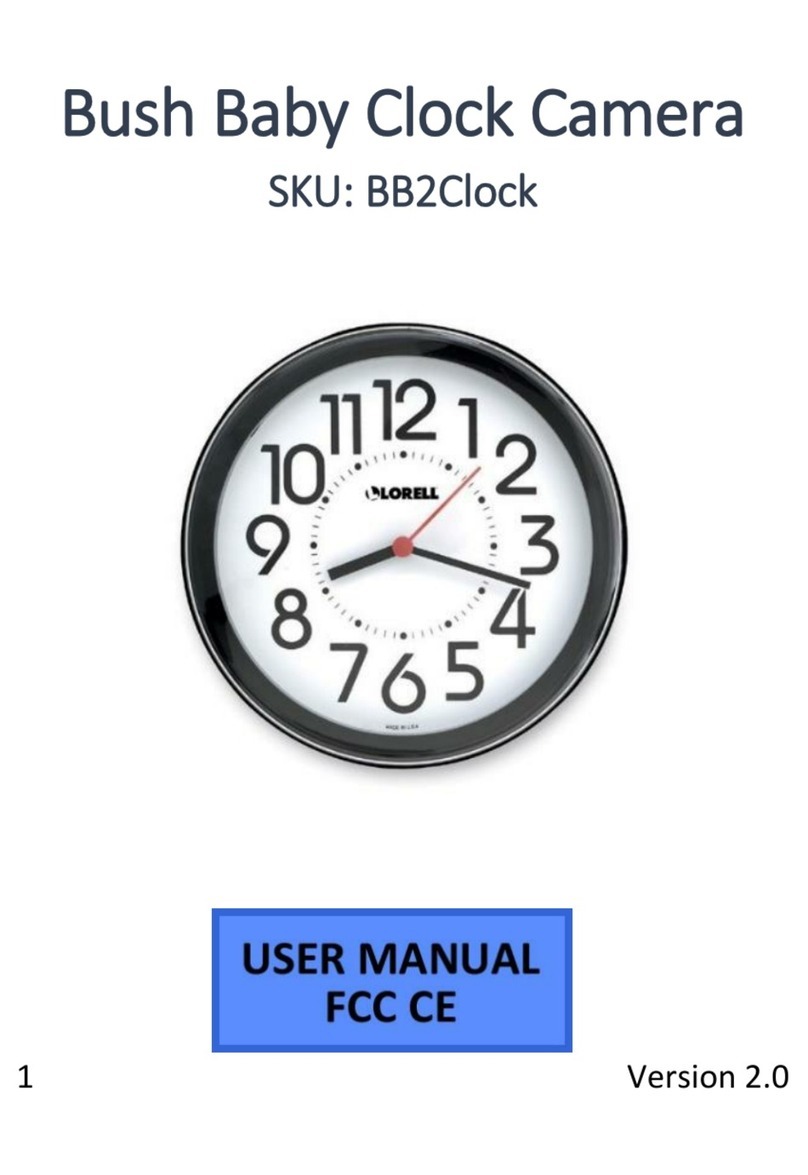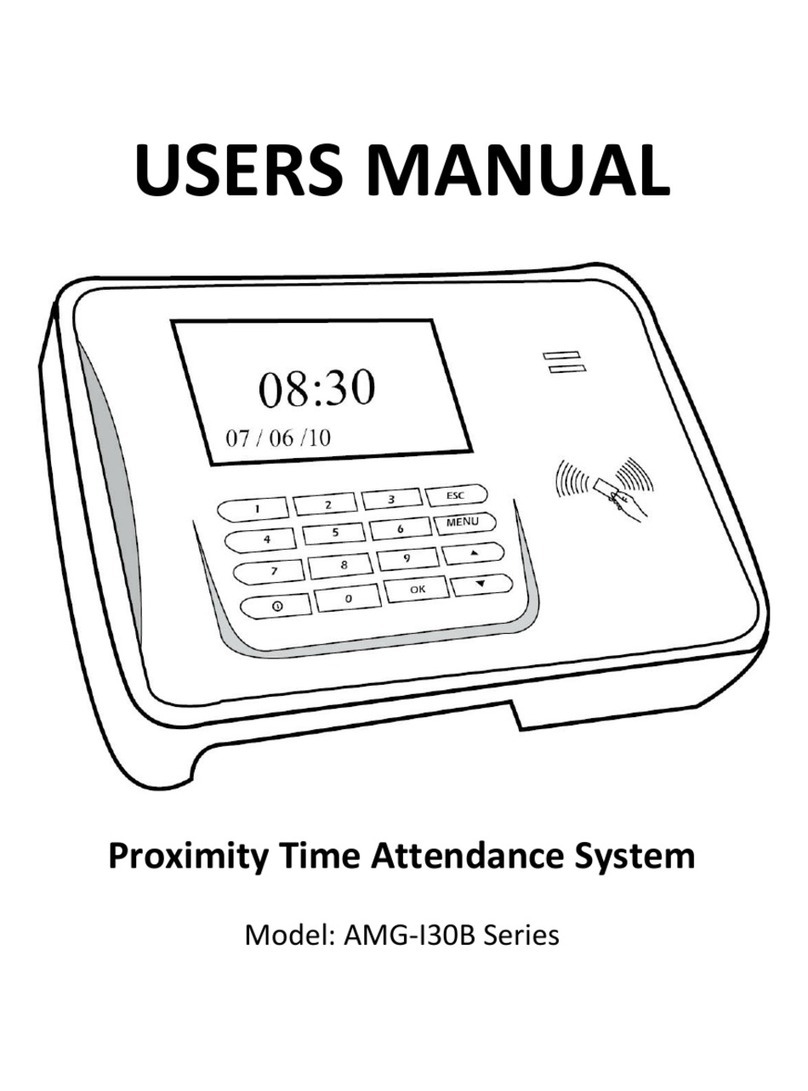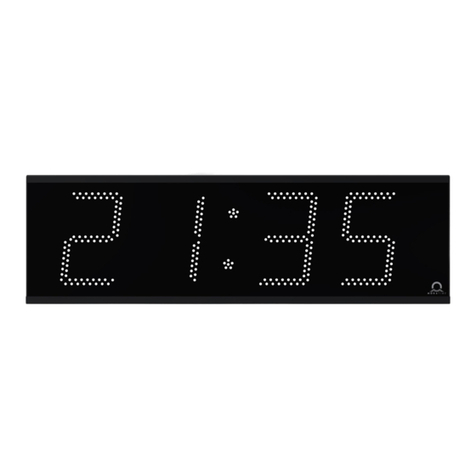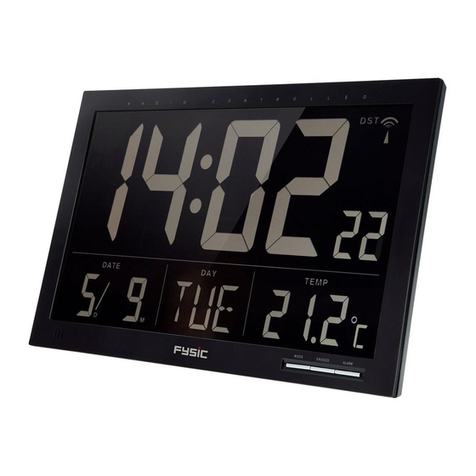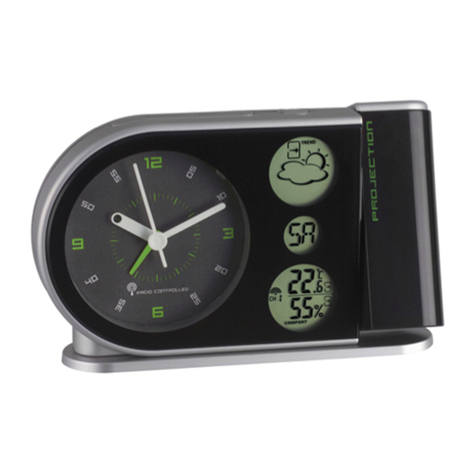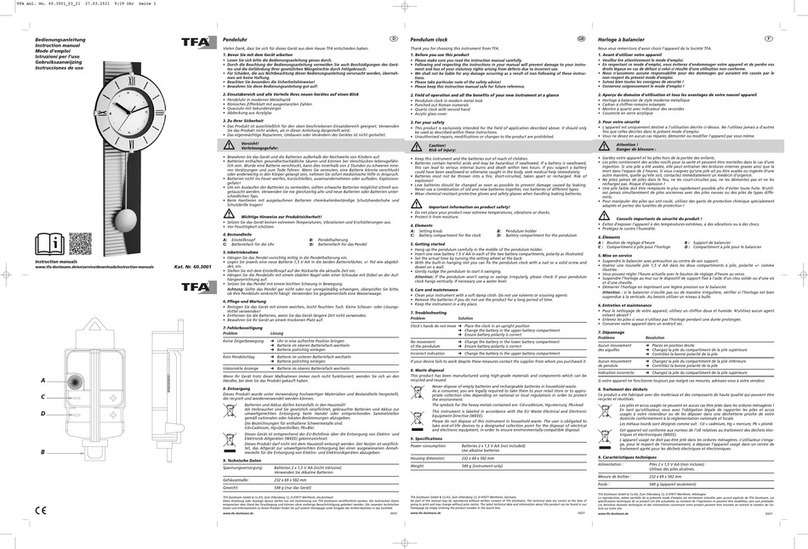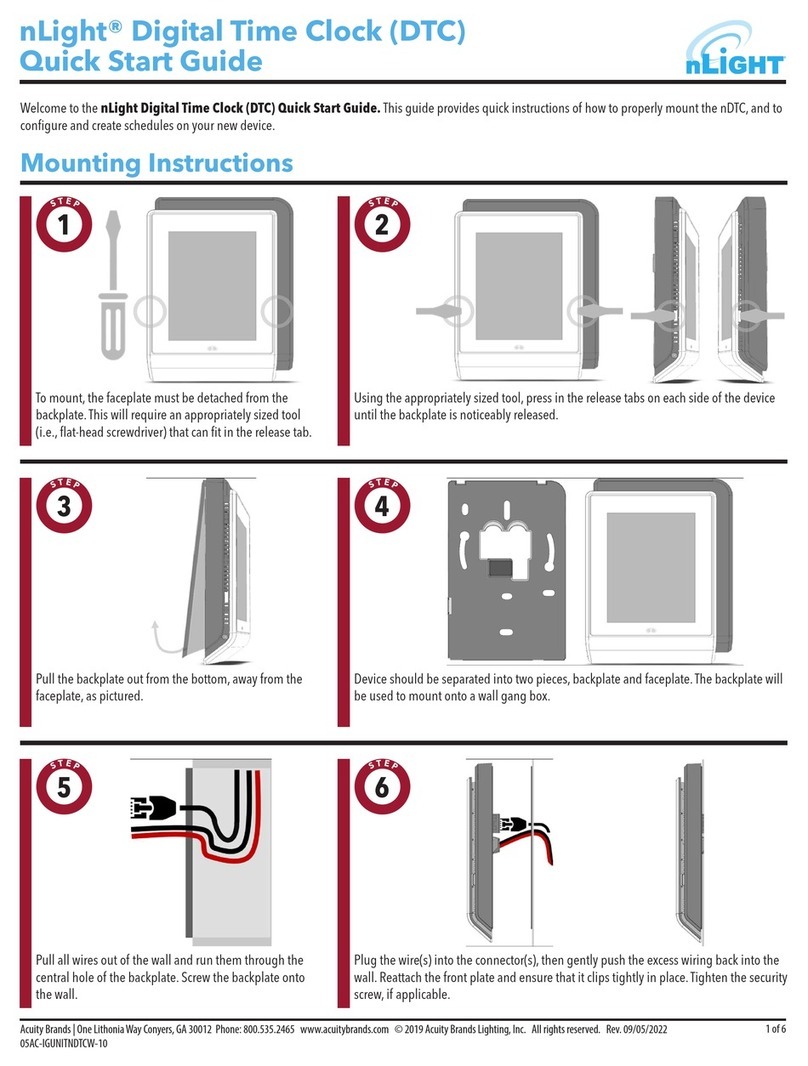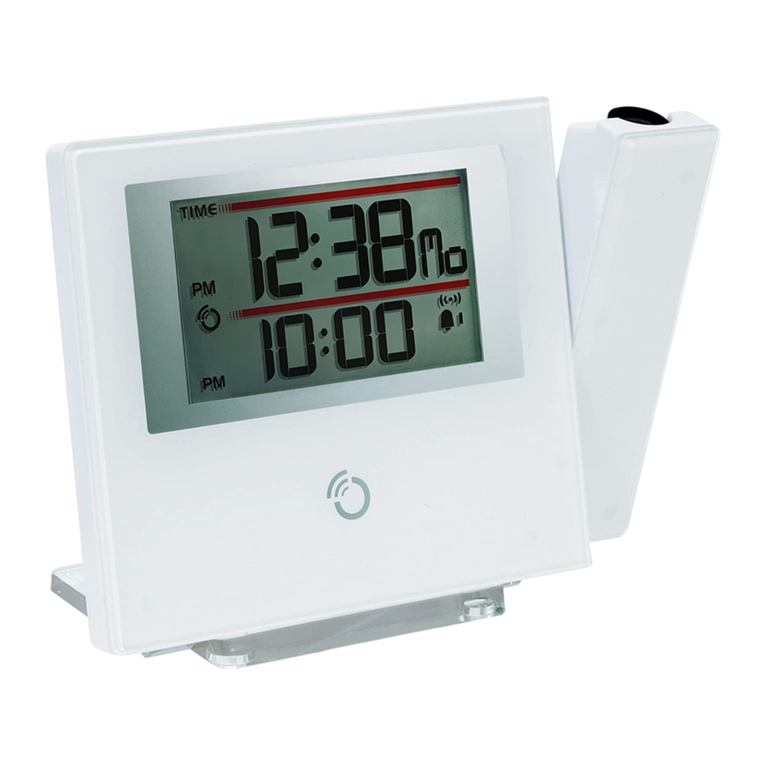Elektor 6-Digit Nixie Clock version 2 User manual

6-Digit Nixie Clock version 2
Assembly Manual
Revision 1 – released 2 2 - 6- 2

This kit is designed for someone who has intermediate experience with assembling electronics.
Please take your time – it will take approximately 3 hours to complete this kit. Ensure your work
area is well lit (daylight preferred) and clean.
ssemble the parts in the order as stated in the instructions - read and understand each step
before you perform each operation for the best chance of success.
The following tools and materials will be required to assemble the clock:
• good quality soldering iron (25-40W) with a small tip (2-3 mm).
• Thin solder wire with no-clean flux. Do not use any flux or grease.
• set of small screwdrivers.
• small wire cutter for electronics.
• wire stripper.
• Long nose pliers.
• hot air soldering station / heat gun / lighter (or alternative).
• multimeter
Reading the entire manual before starting the project is highly advised and will help you
comprehend the overall project.
Disclaimer
ll pictures are for illustration purposes only. ctual product may vary due to product
enhancement.

Schematic and PCB Layout
Main and Display Circuit

Main PCB
Display PCB

Backlight Circuit
Backlight PCB

Assembling the Display PCB
Mount resistors R1, R2, R4, R5, R25 and R26,
27k (red – violet – orange – gold)
Mount resistors R3 and R24, 470k (yellow –
violet – yellow – gold)
Mount the angled pin headers K4, K6, K8, K10,
K12 and K14.
If you wish, you can now remove any excess
solder flux from the solder joints as these will
remain visible when the clock is finished. You
can use a commercial flux remover or isopropyl
alcohol (IP ) for this purpose. Make sure this
stuff never comes into contact with the acrylic
parts of the optional enclosure.
Have the IN-12 nixie tubes (V1 ... V6) and
optional tube socket pins ready for the next
step. Before starting the assembly you can put
the IN-12 nixie tubes temporarily on the PCB
(solder side) to see in which order they look
best. IN-12 nixie tubes have quite some
mechanical tolerances. You can mount the IN-12
nixie tubes with or without tube socket pins.

Mounting the tubes without tube socket pins
Put each IN-12 tube with its pins though the holes of the PCB from the solder side and solder them
temporarily in place by soldering the top pin of each tube.
Now turn over the board and take a look at the alignment of the tubes. If needed, you can still
make corrections by reheating the solder connections.
If you are satisfied with the alignment of the tubes, you can solder the remaining pins. Keep the
temperature of your soldering iron as low as possible and keep the soldering time as short as
possible.
Please note that it will be difficult to replace a defective nixie tube if the tubes are soldered
directly to the board.
Mounting the tubes with tube socket pins (recommended)
Pinch the tube socket pins between your fingers
so they will be more tight. In order to mount
the tubes, you can choose between two
options. You can either slide the tube socket
pins over the pins of the tube and push the tube
with socket pins through the holes of the PCB or
fit the tube socket pins to the PCB and push the
tubes in the socket pins. If you choose the latter
option, make sure the pins of the tubes are
correctly seated into the socket pins.
When all the tubes are in place, turn over the PCB and solder the tube socket pins from the
backside. Do not use too much solder and keep soldering time short.

Solder the small neon lamps L 1 and L 2 into place. The polarity doesn't matter. They shouldn't
protrude as much from the PCB as the nixie tubes.
The display PCB is now finished.

Assembling the Main PCB
Mount the components from low to high. Start
with the small signal schottky diodes D3 and D4,
B T46. Watch the polarity!
Mount the following resistors:
R27: 0,27 Ω (red – violet – silver – gold)
R12, R16: 1k (brown – black – red – gold)
R17: 5k6 (green – blue – red – gold)
R6 ... R9, R11, R23: 10k (brown – black – orange
– gold)
R13: 470k (yellow – violet – yellow – gold)
Mount schottky diodes D1, BYV26-C and D2,
1N5819. Watch the polarity!
Mount the IC sockets for IC7 (8 pins), IC1 ... IC3,
IC8, IC9 (16 pins) and IC4 (40 pins).

Mount the 47k/1 W resistor R28 (yellow – violet
– orange – gold) and trimmer potentiometer P1
(470K). The resistor is a bit of a tight fit. Mount
it so, it hovers a few millimeters above the PCB
as it will get hot when the clock is powered up.
Mount the ceramic capacitors C3, 470 pF and
C1, C4 ... C7, C15 ... C17, 100 nF. You may need
to bend the wires of C3 a bit to get it to fit on
the PCB.
Mount pin headers for S1, Bz1 (2 pole), MOD1
(5 pole), K1 (6 pole) and K15 (7 pole).
Mount the socket headers K3, K5, K7, K9, K11
and K13 (2x5 pole).

Mount the bipolar transistors T1 ... T4, T8
(MPS 42) and T9 (BC557B). For esthetical
reasons and to facilitate mounting, the top of
the transistors should be flush with the top of
the pin and socket headers.
Mount the terminal block K2 and electrolytic
capacitor C18 (220 μF 16 V). Watch the polarity!
Mount the electrolytic capacitors C11, C12 (100
μF 25 V) and C13 (10 μF 25 V). Watch the
polarity.
Mount the red LED LED1. Watch the polarity!
The longest lead should go in the hole closest to
R12. Keep the soldering time as short as
possible as some LEDs are easily damaged by
excessive heat.
Mount the power inductor L1 (100 μH). It is
highly recommended to mount the inductor so
the start of the windings marked by a white dot
is connected to the switching node (D1 and T5).
s such, the outer windings on the ferrite core are connected to the power supply rail and act as
an EMI shield.

Mount the DC/DC step-down converter module
IC6 (OKI-78SR-5/1.5-W36C). The power inductor
on the module should point towards K1.
Mount MOSFET power transistor T5 (IRF644).
Please note that this is an electrostatic sensitive
device. It is recommended to touch an earthed
metal object before mounting the transistor. s
a better alternative, you can also wear an anti
static wrist strap and combine this with a
grounded ESD mat. The metal tab of the
transistor should point towards D1.
Mount the electrolytic capacitor C10 (10 μF 250 V). Watch the polarity!
Put IC7 (MC34063) in its socket. Watch the position of the notch!
Make sure trimmer potentiometer P1 is in its
middle position.
Power up the bord using a 9 V power supply
capable of delivering at least 500 m . lab
power supply with adjustable current limit is
preferable. Measure the nixie anode voltage
across 1 W resistor R28. djust the voltage to
approximately 170 V. Be careful not to touch the
170 V anode voltage and do not touch R28 as it
may get hot.
Now check the 5 V power rail voltage. You can
measure this voltage on pin header K1.
Do not continue the build of the clock if the
voltages are not correct but look for assembling
faults instead.
If everything is ok, disconnect the power supply.

Put the Russian nixie drivers IC1 ... IC3, IC8 and
IC9 (K155ID1 / 74141) in their sockets. Put PIC
controller IC4 (PIC18F44K22-I/P, PIC18F45K22-
I/P or PIC18F4420-I/P) in its socket.
Watch the position of the notches on all ICs!
Remove the GPS module from its anti static bag
and put it on a flat surface. Connect the GPS
patch antenna to the GPS module using the
coaxial micro RF connector. The connector
might be a bit of a tight fit but be careful not to
damage it.
Finally mount a 5 pole socket header on the
bottom side of the module.
Connect the GPS module to the main board and
fixate it using 2 M3X6 machine screws, 4 nylon
M3 washers and a 10 mm hex standoff. The
main board is now finished.

Putting the PCBs together
Connect the display board to the main board.
You can now connect a power supply again and
run a first test. fter power up, the nixie tubes
show the firmware version and should then
cycle between digits one after each other. Note
that the first nixie tube only can show numbers
between 0 and 3.
fter the cycling test, the clock will show a baud
rate 4800 and then 9600 when it tries to get the
time from the GPS module.
Shortly thereafter, the time is displayed. Depending on your local time zone, this may be or not be
correct but this can be adjusted later. Please note that dimming may be active too resulting in a
very dim display. This can also be adjusted later.
Installing the backlight PCB is optional. The nixie
clock can work without the backlight PCB too. If
you don't want to install the backlight PCB, you
can skip the following steps and go directly to
the wiring of the clock.
Mount a 3 pole pin header to the solder side of
the backlight board. This board comes
preassembled with the SMT parts already in
place.

Screw 2 plastic 8 mm standoffs to the mounting holes of the backlight board. If you are planning to
put the nixie clock into the designated acrylic enclosure from Elektor, you should use two M3x16
machine screws and two nylon M3 washers to hold the standoffs in place. The M3x16 machine
screws should protrude from the standoffs. Please note that the M3x16 screws are part of the kit
for the enclosure, they are not included with the nixie clock kit.
If you are not going to use the enclosure, mount the spacers to the backlight board using two
M3x6 screws and two nylon M3 washers.
ttach the backlight PCB to the display PCB. Use 2 8 mm standoffs if you are going to use the
Elektor enclosure. These are included with the kit for the enclosure. Otherwise, use two M3x6
machine screws and two nylon M3 washers.

Wiring the clock
If you are not going to use the backlight PCB,
you can as well skip this step.
Connect two 3 pole socket headers together
using 10 cm of green, black and red wire.
Insulate the solder joints using 14 mm pieces of
3.2 mm heat shrink tube.
Connect a 2 pole socket header to the push
button using 5 cm of black and red wire.
Insulate the solder joints using 14 mm pieces of
3.2 mm heat shrink tube.
Solder 5 cm pieces of black and red wire to the
DC connector. Insulate the solder joints using 14
mm pieces of 3.2 mm heat shrink tube. Strip the
other ends of the wires but do not tin them.
Solder the wires of the buzzer to a 2 pole socket
header. Insulate the solder joints using 14 mm
pieces of 3.2 mm heat shrink tube.

Connect the DC connector wires to terminal block K2. Watch the polarity! Connect the push button
to S1 and connect the buzzer to Bz1. Watch again the polarity!
If you are using the backlight PCB, connect it to K1 on the main board using the 3 pole socket
headers and wires we prepared a few steps earlier. Take care that the connections D, 0 and + on
the backlight PCB are connected to the same D, 0 and + pins of connector K1 on the main board.
You can now test your clock again if you wish to do so.
The construction of the electronics of your clock
has now been completed. Please read further, if
you want to put the clock in the acrylic
enclosure from Elektor.

Assembling the enclosure
Disconnect the DC connector, push button and buzzer from the main PCB.
Remove the protective finish from the front panel and slide it over the IN-12 nixie tubes and neon
lamps of the clock assembly and attach it to the display PCB using two M3x6 machine screws.
Remove the protective finish from the baseplate
and the acrylic support.
Mount the acrylic support to the baseplate
using an M3x12 machine screw and an M3 nut.
Do not over tighten the screw as the acrylic may
break. Use preferably a watchmakers or a
jewelers screwdriver as these will prevent you
from using too much force.
Screw two M3x8 machine screws all the way
from the bottom side through the base plate
and slide two 3 mm plastic spacers over the screw ends on the top side.
Position the main PCB on top of the baseplate so it fits over the earlier installed M3x8 screws and 3
mm spacers. Make sure the tabs on the front panel fit into the slots of the baseplate.
ttach the main PCB to the baseplate using four additional M3x8 machine screws and four 3 mm
spacers.

Remove the protective finish from the acrylic GPS patch antenna mounting plates. Place the
antenna between the acrylic parts and screw everything together using two nylon M4x12 machine
screws.
Remove the protective finish from the back
panel and attach the power connector using
two M2x6 machine screws and two M2 nuts.
Watch the orientation of the panel so the wires
protrude at the right side. The engraving should
end up at the inside of the enclosure. ttach the
push button to the back panel. 10mm socket
will come in useful here, if not pliers will do the
job. If you decide to use pliers, be careful not to
scratch the acrylic.
ttach the buzzer to the back panel using four
M2X6 machine screws and two 10 mm standoffs with internal M2 thread. Finally, attach the patch
antenna assembly to the back panel using a nylon M4x12 machine screw and a nylon M4 nut.
Connect the wires again to the main PCB and guide the tabs of the back plate through the slots of
the base plate.

Remove the protective finish of the side panels. It's best to remove the small pieces of the
protective finish inside engravings first and work your way from the inside to the outside of the
panels. The protective finish can be a bit difficult to remove but keep in mind that it was needed to
protect the acrylic from laser fumes during manufacturing.
Finally guide the tabs of the side panels into the slots of the base panel. The engraving on the
panels should face the inside of the enclosure.
Remove the protective finish of the top panel and fit it over the front, back and side panels, with
the engraving again facing the inside of the enclosure. Finally screw the bottom and top panel
together using the brass tubes, threaded rods, cap nuts and nylon M4 washers.
Congratulations!!! You've finished your clock.
This manual suits for next models
2
Table of contents
Popular Clock manuals by other brands
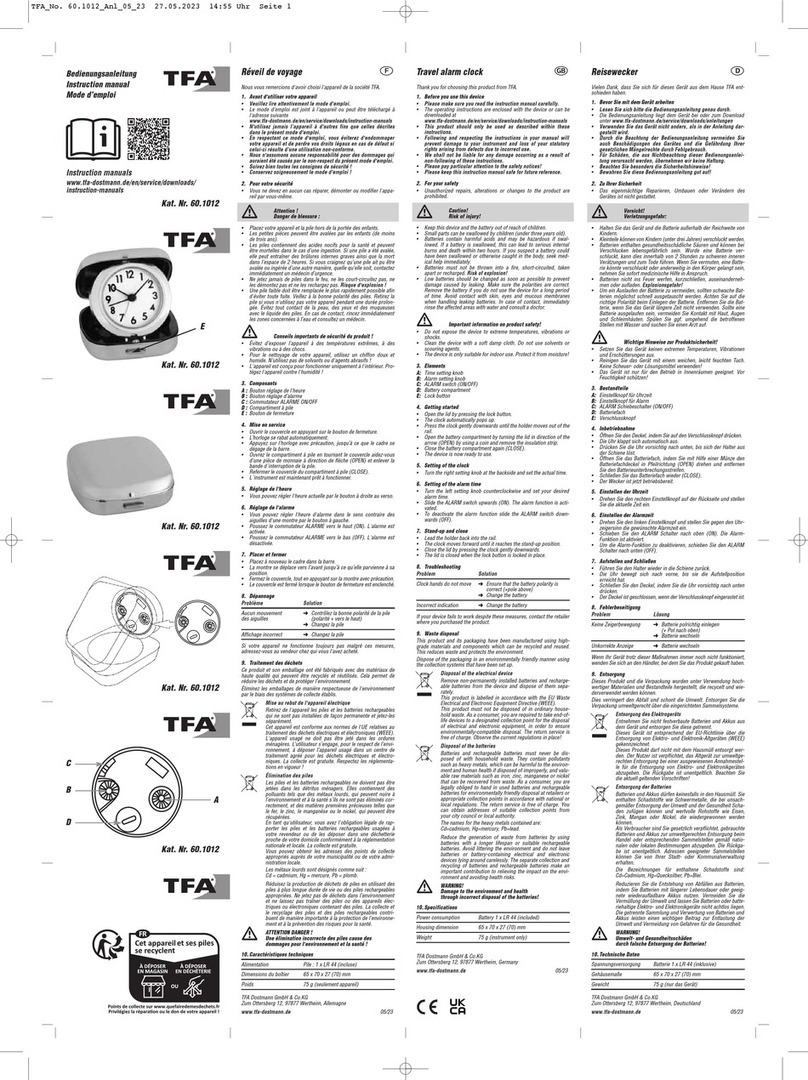
TFA
TFA 60.1012 instruction manual
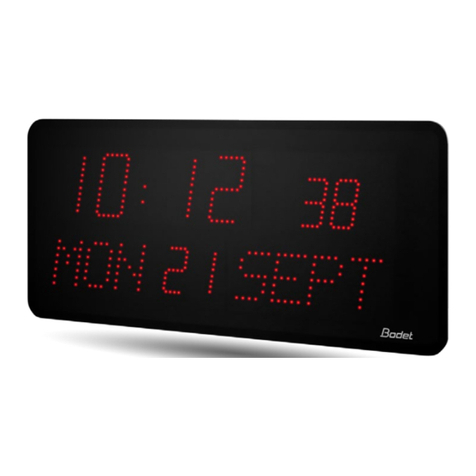
Bodet
Bodet 5 Seconde Installation and operation manual
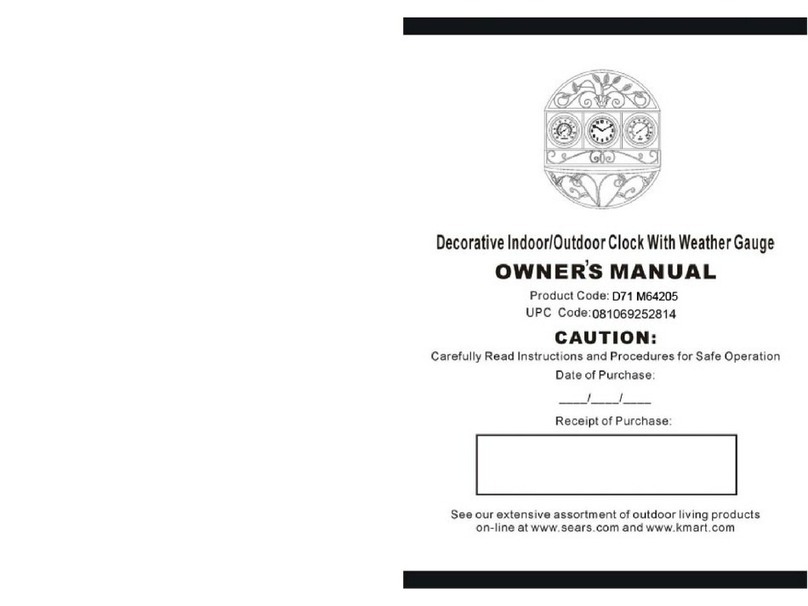
Sears
Sears D71 M64205 owner's manual
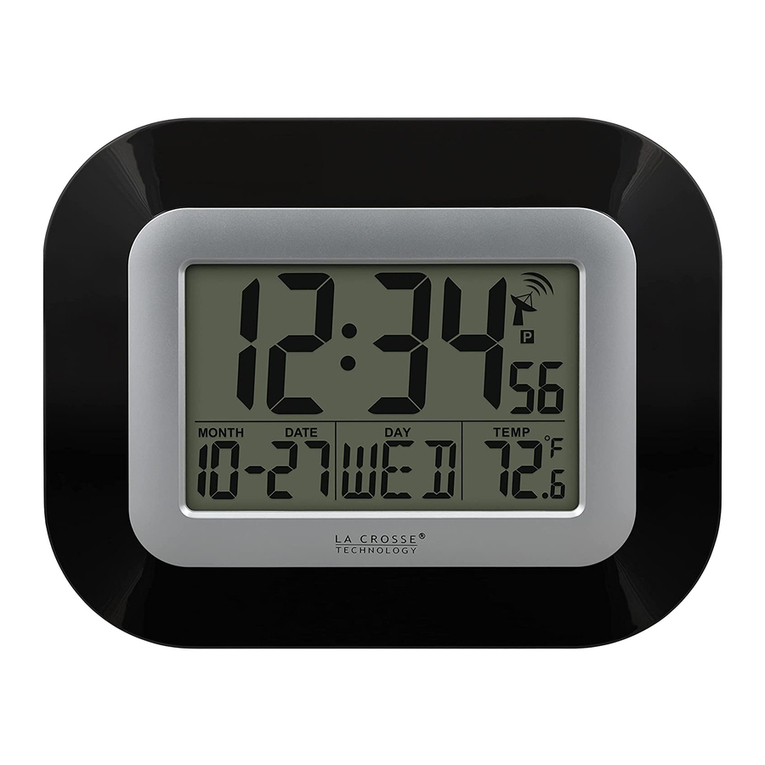
La Crosse Technology
La Crosse Technology WT-8005U manual

Eurochron
Eurochron 1561128 operating instructions
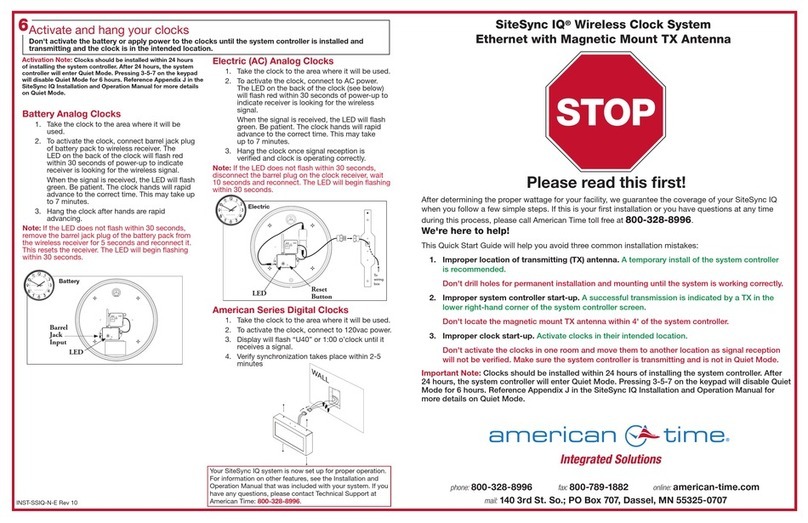
American Time
American Time SiteSync IQ Quick start installation guide
